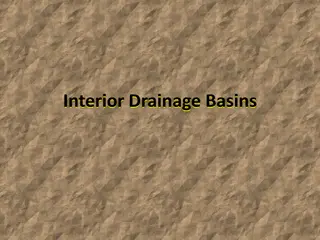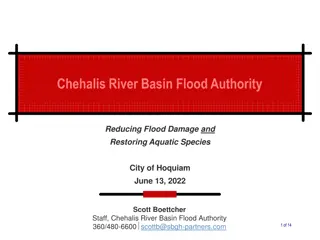Chehalis Basin CFAR Program Overview
The Chehalis Basin Strategy Community Flood Assistance & Resilience (CFAR) Program aims to address flood-related challenges in the Chehalis River Basin through multiple reports and recommendations, emphasizing the need to reduce damage to residences, prevent new development in floodplains, and enhance land use policies. The program focuses on mitigating damage from rising floodwaters, channel migration, wet floodproofing, and home elevation to minimize structural and property losses. The roles and responsibilities involve program administration, project approval, contractor collaboration, community engagement, and compliance monitoring to ensure effective implementation of flood resilience strategies in the Chehalis Basin.
Download Presentation

Please find below an Image/Link to download the presentation.
The content on the website is provided AS IS for your information and personal use only. It may not be sold, licensed, or shared on other websites without obtaining consent from the author.If you encounter any issues during the download, it is possible that the publisher has removed the file from their server.
You are allowed to download the files provided on this website for personal or commercial use, subject to the condition that they are used lawfully. All files are the property of their respective owners.
The content on the website is provided AS IS for your information and personal use only. It may not be sold, licensed, or shared on other websites without obtaining consent from the author.
E N D
Presentation Transcript
Chehalis Basin Strategy Community Flood Assistance & Resilience (CFAR) Program Chehalis River Basin Flood Authority January 23, 2020
Why CFAR? Element of multiple reports and recommendations: Work Group OFM report (Ruckelshaus Center), December 2012 Work Group recommendations report (Ruckelshaus Center), November 2014 Bucoda Foundation Flood Opening Lessons Learned (Flood Authority), July 2016 Work Group budget recommendations to the Governor, December 2016 Reduce the cost of repetitive damage to residences in the floodplain through a strategic program of buyouts and flood proofing, and encourage a comprehensive effort to prevent new development in the Basin from increasing flood damages. Further enhancements to state and local land use policies will help ensure new development and other land management activities do not increase the risk of additional flood-related damages and, to the extent possible, reduce damages and costs to existing development affected by flooding. 2
Why CFAR? Chehalis Basin Board - Fall 2018 In addition to damage caused by rising flood waters, damage also occurs in a number of places in the Chehalis Basin as a result of river channels migrating, eroding land and damaging structures and beneficial uses of the land. The CFAR program will need to address damage from both of these issues, rising flood waters and channel migration. Cowlitz River, 2007 Newaukum River, 2017 3
Why CFAR? Wet floodproofing floodable areas Home Elevation, Thurston County Draft Economics Study Update (EES Consulting) June 2017 The greatest flood damage reduction benefit from most action alternatives comes from eliminating damage to structures and their contents. The avoided damages due to floodproofing buildings or buying out properties over 100 years is significant. 4
Roles and Responsibilities Office of Chehalis Basin (OCB) o Program administration and management o Project approval o Contracting with project contractors Community o Publicize the program, talk to property owners o Review and comment on project applications o Project permitting, inspections, approval o Monitor owner compliance with non-conversion or re- use agreement 6
Roles and Responsibilities Property Owners o Contribute to the project o Agree to not convert the property to negate the protection provided o Agree to keep flood insurance on the building Flood Authority o Help publicize the program o Review and comment on applications 7
Eligible Actions Technical assistance Residential and commercial properties Acquisition, relocation of buildings, and/or clearance of a parcel, with deed restriction Elevation, dry floodproofing, other retrofitting measures, with non- conversion agreement Channel migration zone easements, small habitat friendly, permittable bank protection Not eligible: Properties to be protected by another Strategy flood damage reduction project Not eligible for retrofitting: accessory structures and dilapidated buildings 8
Project Priorities Properties facing the greatest flood or erosion risk Least costly technique that provides equivalent protection Projects with cost sharing from other sources Projects that provide a clear benefit to the Aquatic Species Restoration Plan (ASRP) 9
Relationship to Local Projects Design and construct local projects that will provide immediate flood damage reduction including the protection of critical infrastructure, wellheads, wastewater treatment plants, roads, homes, and businesses. Concurrent with these projects, develop and implement a long-term strategy for localized flood damage reduction actions. 10
Next Steps Define mechanics for program administration Continued coordination with local governments to guage community and property owner interest Draft project solicitation forms and criteria Fund projects in 2 or 3 communities that are ready to proceed 11























